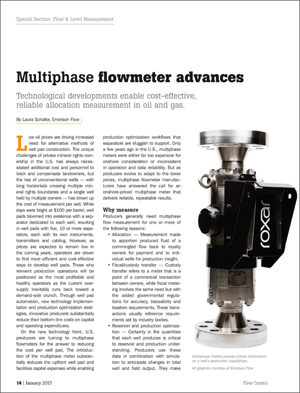In oil and gas production well pads and offshore platforms, separators perform the work of breaking out the oil, gas and water into separate component streams. Test separators have historically taken flows from individual wells, known as well tests, to determine the percentages of these components on a periodic basis. These components are then returned into the production flow streams. The processing facility with test separators must include additional piping and valves to perform these well tests.
Technology has continued to advance where these component percentages can be measured by multiphase flowmeters without the need for separate test separators.
In a Flow Control magazine article, Multiphase Flowmeter Advances, Emerson’s Laura Schafer describes these advancements and how they enable a more cost-effective, reliable allocation measurement for oil & gas producers.
 Laura opens noting how well pad facility worked in the high oil price era:
Laura opens noting how well pad facility worked in the high oil price era:
While days were bright at $100 per barrel, well pads bloomed into existence with a separator dedicated to each well, resulting in well pads with five, 10 or more separators, each with its own instruments, transmitters and cabling.
Now that a lower oil price environment has been with us for several years and perhaps more to come, oil & gas producers are looking for ways to optimize their capital spending, including well pad facility design. Laura highlights how multiphase flowmeters can help:
The introduction of the multiphase meter substantially reduces the upfront well pad and facilities capital expenses while enabling production optimization workflows that separators are sluggish to support.
She addresses the technology advancements:
Only a few years ago in the U.S., multiphase meters were either far too expensive for onshore consideration or inconsistent in operation and data reliability. But as producers evolve to adapt to the lower prices, multiphase flowmeter manufacturers have answered the call for an onshore-priced multiphase meter that delivers reliable, repeatable results.
These meters are used for produced fluid allocation measurements for royalty owners, fiscal/custody transfer, reservoir and production optimization, and flow assurance to monitor and control for scale, wax, hydrate formation, corrosion and erosion. Also, by using multiphase meters, the well pad requires:
…significantly less piping, smaller footprint, and reduced intervention and maintenance using direct measurement with multiphase meters. With multiphase meters, each well can be tested individually and continually without having to redirect eliminates the need for additional automation or manual intervention to test a well. This allows commingling of multiple well pads and consolidation of separation facilities at a central gathering facility.
The multiphase flowmeter technology was introduced for challenging offshore platform conditions. Over time, it has been refined for onshore well pad applications. It includes:
…flexible, modular platforms that allow producers to purchase only the multiphase modules required to achieve desired accuracy and performance range. The modularity, coupled with advances in the underlying first principles models, allows many producers to select and operate a multiphase meter without the gamma module, eliminating concerns surrounding transport and upkeep of radiation sources. Additionally, verification routines in the software continuously check conditions to ensure well characteristics are within the calibrated range of the meter and provide real-time updates to remote operators when conditions change, which provides additional confidence in the measurement.
Laura concludes:
As oil and gas producers evolve their operations to deliver high-quality, reliable and real-time data cost-effectively, multiphase meters prove to be an exciting enabler of that vision. Delivering reliable data with lower capital costs for the facility, the new generation of modular meters has the flexibility to meet the changing needs of the well over the life of the reservoir.
Read the article and visit the Emerson multiphase metering page for more on the technology and its application in oil and gas production. You can also connect and interact with other flow measurement and oil & gas experts in the Flow and Oil & Gas groups in the Emerson Exchange 365 community.





